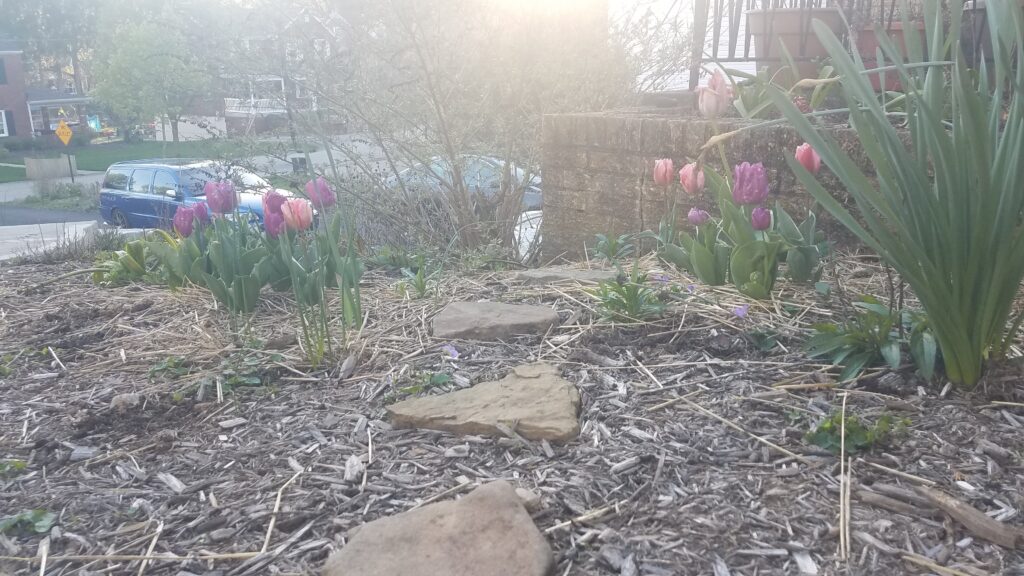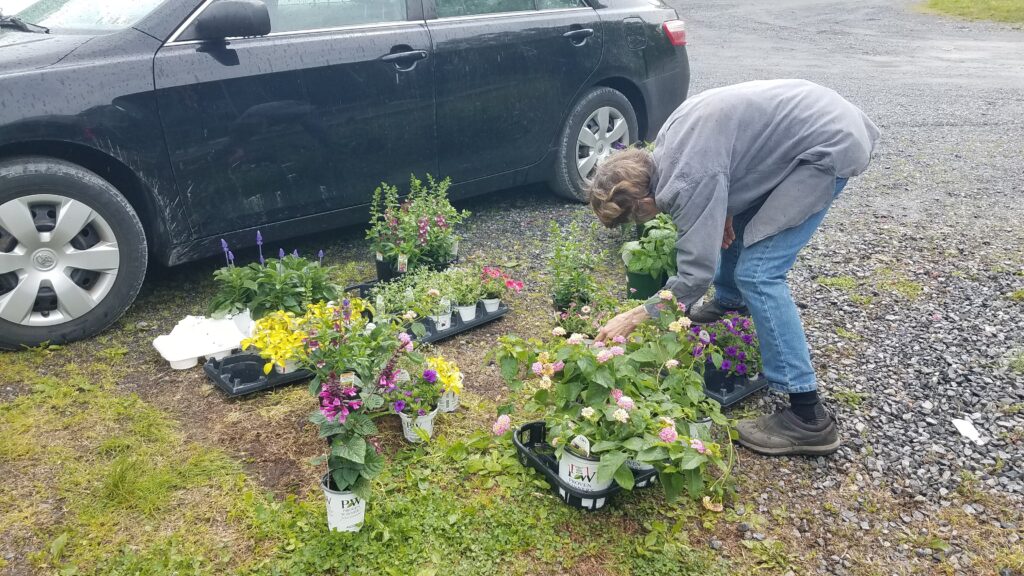I saw some advice a month or so ago that you should spend 20 minutes in nature every day, unless you’re a busy person, in which case you should make it 60 minutes. Of course, this year, in which I needed time in my garden more than ever, I got far less of it. Between lingering physical exhaustion from COVID [1] and/or depression, extra weekends away to visit my dad, and extra time devoted to the Climate Lab [2] (including spending four weeks out of the country during prime gardening time), my garden was put on the back burner in this, its seventh, year.

Knowing that I would have less time and energy this year, I promised myself no scope creep: I would just maintain and plant in the existing garden space, not expand any garden beds. (For the record, there was some garden bed expansion out from the new walkway that went in two years ago – not too much!) Therefore, much of my gardening this year involved adding shrubs and large perennials in the front of the house while simply trying to keep pace with the weeds in the back. As of the writing of this post, I am still not done with my major spring task of weeding and spreading mulch.
Spring Comes Again
I didn’t have much motivation to do anything this spring. It was a very difficult few months for my family, and most of what got me through every day was recognizing that there were things that needed to get done and continuing to put one foot in front of the other to do them, like the point in a marathon at which I start questioning my life choices but keep moving forward anyway. But there is always a sense of hope and excitement that comes with the first signs of life returning to the world after winter. And this spring, what came up were the tulips that my mom helped me pick out at her twin sister’s garden center the prior fall.

When I started my garden, I talked a big game about only planting native plants (and only straight species at that). But since then I’ve relaxed my perspective, recognizing the value of native cultivars [3] and early-blooming non-native plants, such as tulips and daffodils. Every spring my mom and I would call each other when we saw our first crocuses popping up – it was a joyful event for us and an early source of food for bees and other pollinators. This year I recognized that my garden should be full of things that bring me joy, no matter what they were – because I really needed it.
I didn’t have time to do much other than spray Deer Mace [4] on the tasty tulips until the end of May. For my birthday last year my mom secretly certified my garden with the National Wildlife Federation, [5] and for my birthday this year, I followed up by certifying it as a Monarch Waystation. [6] As a Monarch Waystation, I needed to have a variety of annuals and perennials, and I am always happy to oblige on that front. So, also for my birthday, I bought myself a carload of shrubs and perennials at the native nursery near me, [7] and my aunt sent me home with a carload of annuals for my porch gardens and planters from her garden center back east. [8]

The Never-ending Battle
Unfortunately, at least with the grasses fighting to remain in what used to be sections of lawn, the longer it takes to get started pulling them, the longer it will take to do it. That is why about three of the eight yards of mulch I had delivered Memorial Day weekend are still taking up a parking spot in the driveway, much to Christian’s chagrin. For the record, I have promised him the driveway will be free again before winter, but I still have a significant amount of weeding to do first, despite the fact that it’s all I was doing in the garden this year.
In reality, weeding wasn’t all I did, but it sure felt like it, especially since I didn’t get any corn gluten down this year (despite previously learning from that mistake the hard way). [9] I cut a growing forest of thistle down to the ground behind our house twice already (and will need to do it again before I’m done for the year). [10] I still haven’t done any weeding along our lengthy driveway, and the grasses there have long since gone to seed, which will make my work even harder next year. I can only hope I’ll have more time to spend in the garden and can get an earlier start in the spring in order to counteract what was a completely unchecked proliferation of weeds this year.

On a somewhat positive note, my common milkweed is thriving, even though that also represents an increased amount of work for me to do next year in thinning it out so it doesn’t crowd other plants I want to keep around. I did a fairly good – but not perfect – job of clipping seed pods before they burst this fall. Some seeds may or may not have landed across the retaining wall where my neighbor’s pokeweed continues to be a menace. [11] I suppose we may learn which of the two is more aggressive in coming years.
New Additions
As with last year, I spent far more time weeding than planting. In fact, it took me until mid-October just to finish planting what I bought at the end of May, and I think a few plants suffered sitting in pots on my front porch all summer. I hope that they survive, but we’ll find out in the spring. Here, at least, is a list of what perennials went into the ground this year, mostly in the front to fill in the new garden space on either side of our “new” walkway [12]:
- Golden groundsel – Packera aurea [13]
- Narrowleaf sundrops – Oenothera fruticosa var tetragona (3) [14]
- Tall larkspur – Delphinium exaltatum (6) [15]
- White turtlehead – Chelone glabra (3) [16]
- Shrubby St. John’s Wort – Hypericum prolificum (3) [17]
- Hairy beardtongue – Penstemon hirsutus (3) [18]
- Rock harlequin – Corydalis sempervirens (6) [19]
- Wild blue indigo – Baptisia australis (3) [20]
- Brown-eyed Susans – Rudbeckia triloba (8) [21]
- Goatsbeard – Aruncus dioicus (3) [22]

And the native shrubs that have made their way into various parts of the yard:
- Winterberry – Ilex verticillata (2) [23]
- Sweet pepperbush – Clethra alnifolia [24]
- Lowbush blueberry – Vaccinium angustifolium [25]
- Common ninebark – Physocarpus opulifolius [26]
- Northern bayberry – Morella pensylvanica (to replace the one from last year that didn’t make it) [27]
As I said, I still have plenty to do before calling it quits for the year, including weeding, mulching, and planting a box full of narcissus bulbs my aunt gave me this past spring. This whole year has been a difficult one in multiple ways, and I have frequently felt little desire to do anything or even hope that there is a reason to bother putting in the effort. But every time I’m outside, looking at my garden, seeing the life that continues regardless of what else is going on in the world, I think of the concept that planting a garden is the ultimate expression of hope in the future. It requires patience, persistence, and flexibility: you will never reach the end point, and what you do achieve will look very little like what you originally imagined, but it will be a testament to the fact that life goes on.
And with that thought, I am going to head outside to put my hands in the dirt.
Thank you for reading.
[1] https://radicalmoderate.online/feeling-flirty/
[2] https://radicalmoderate.online/tag/climate-lab/
[3] https://radicalmoderate.online/planting-a-pollinator-garden-part-1/
[4] https://naturesmace.com/collections/deer-rabbit-repellent
[5] https://radicalmoderate.online/pollinator-garden-update-2023/
[6] https://radicalmoderate.online/monarch-waystations/
[7] https://arcadianatives.com/
[8] https://www.facebook.com/pharogardencentre/
[9] https://radicalmoderate.online/pollinator-garden-update-2023/
[10] https://radicalmoderate.online/thinning-a-thicket-of-thistle/
[11] https://radicalmoderate.online/bad-fences-make-good-neighbors-catchweed-and-pokeweed/
[12] https://radicalmoderate.online/concrete/
[13] https://www.wildflower.org/plants/result.php?id_plant=PAAU3
[14] https://www.wildflower.org/plants/result.php?id_plant=OEFRT
[15] https://www.wildflower.org/plants/result.php?id_plant=DEEX
[16] https://www.wildflower.org/plants/result.php?id_plant=CHGL2
[17] https://www.wildflower.org/plants/result.php?id_plant=HYPR
[18] https://www.wildflower.org/plants/result.php?id_plant=PEHI
[19] https://www.wildflower.org/plants/result.php?id_plant=COSE5
[20] https://www.wildflower.org/plants/result.php?id_plant=BAAU
[21] https://www.wildflower.org/plants/result.php?id_plant=RUTR2
[22] https://www.wildflower.org/plants/result.php?id_plant=ARDIA
[23] https://www.wildflower.org/plants/result.php?id_plant=ILVE
[24] https://www.wildflower.org/plants/result.php?id_plant=CLAL3
[25] https://www.wildflower.org/plants/result.php?id_plant=VAAN
[26] https://www.wildflower.org/plants/result.php?id_plant=PHOP
[27] https://www.wildflower.org/plants/result.php?id_plant=MOPE6
0 Comments